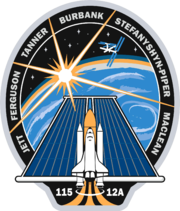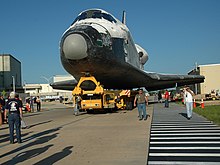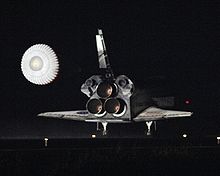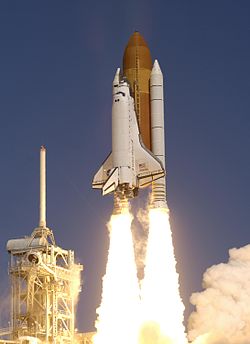STS-115
| COSPAR ID | 2006-036A |
|---|---|
| SATCAT no. | 29391 |
| Crew | |
| Members | 6 |
| End of mission | |

 | |
STS-115 was the first Space Shuttle assembly mission to the International Space Station after the Columbia disaster, following the two successful Return to Flight missions, STS-114 and STS-121. The mission used the Space Shuttle Atlantis, which lifted off on 9 September 2006 from Launch Pad 39-B at the Kennedy Space Center in Florida as planned at 11:14:55 EDT (15:14:55 UTC).
The mission is also referred to as ISS-12A by the ISS program. The mission delivered the second port-side truss segment (ITS P3/P4), a pair of solar arrays (2A and 4A), and batteries. A total of three spacewalks were performed, during which the crew connected the systems on the installed trusses, prepared them for deployment, and did other maintenance work on the station.
STS-115 was originally scheduled to launch in April 2003. However, the Columbia accident in February 2003 pushed the date back to 27 August 2006, which was again moved back for various reasons, including a threat from Hurricane Ernesto and the strongest lightning strike to ever hit an occupied shuttle launchpad.
Crew
The crew, having been selected in 2002, had to wait one of the longest periods of time between crew selection and actual flight, about four years.
- Brent Jett (4), Commander - NASA
- Christopher Ferguson (1), Pilot - NASA
- Joseph Tanner (4), Mission Specialist - NASA
- Daniel Burbank (2), Mission Specialist - NASA
- Heidemarie Stefanyshyn-Piper (1), Mission Specialist - NASA
- Steve MacLean (2), Mission Specialist - CSA (Canada)
Number in parentheses indicates number of spaceflights by each individual prior to and including this mission.
Mission highlights

The primary mission objective was delivery and installation of the second left-side ITS P3/P4 Truss segment, a pair of solar arrays, and associated batteries.
Canadian Space Agency astronaut MacLean became the first Canadian to operate Canadarm2 and its Mobile Base in space as he was handed a new set of solar arrays from Tanner controlling the original Canadian robotic arm, the Canadarm. MacLean performed a spacewalk, becoming only the second Canadian, after Chris Hadfield to do so.
Mission objectives
- Delivery and installation of two truss segments (P3 and P4)
- Delivery and deployment of two new solar arrays (4A and 2A)
- Perform three spacewalks to connect truss segments, remove restraints on solar arrays, and prepare the station for the next assembly mission by STS-116
Mission background
August 27 - September 7 (delays)
Atlantis was rolled out from the Orbiter Processing Facility to the Vehicle Assembly Building (VAB) on 24 July 2006. It was lowered onto the Mobile Launcher Platform on 26 July and rolled out to Pad 39B in the early morning hours of 2 August. The rollout was scheduled for 31 July, but a storm in the vicinity of the Kennedy Space Center resulted in a delay of two days from fears of the orbiter being hit by lightning, which could cause immeasurable damage.

On the weekend of 5 August to 6 August, engineers completed a "flight readiness" check of the shuttle's main engines, which were deemed ready for launch. The crew arrived at the Kennedy Space Center 7 August for four days of launch rehearsals, including a practice countdown 10 August.[1]

For the first time ever, NASA managers decided to move the STS-115 launch date forward to August 27 to obtain better lighting conditions to photograph the external tank.[2] The launch window was co-ordinated with the Soyuz TMA-9 launch in mid-September, which will deliver a new ISS crew and fresh supplies. The Soyuz spacecraft operationally will not dock to the station while the space shuttle is there.[3]
Top NASA managers held a Flight Readiness Review (FRR) meeting August 15 and August 16 to finalize the launch date.[4] Foam loss from the external tank was a key issue at this meeting because on August 13, NASA announced there was an average amount of loss from the external tank of STS-121, the previous mission.[5] Columbia's demise was due to a piece of foam, shed from its external tank, striking the shuttle's left wing during launch and causing a hole that was breached during re-entry.
The meeting also discussed problems with the bolts securing the shuttle's Ku-band antenna, which might not have been threaded correctly. The installation had been in place for several flights and hadn't experienced any problems.[6] At the end of the two day meeting, NASA managers had decided to proceed with the launch on August 27, 2006. However, on 18 August 2006, NASA decided to replace the antenna bolts with Atlantis still on the launch pad. NASA had no procedure to replace these on the pad, but the work was nonetheless completed by August 20, without affecting the planned launch date.[7]
On 25 August 2006, a direct lightning strike, the most powerful recorded at Kennedy Space Center, hit the lightning rod atop the launch pad.[8] As a result, on August 26 the Mission Management Team ordered the mission postponed for at least 24 hours to assess damage.[9] On August 27, the decision was made to postpone the launch for another 24 hours, making the earliest possible launch date Tuesday, August 29, still unassured that there was no damage from the lightning strike and taking into account the possible threat from Hurricane Ernesto.

On August 28 it was decided to postpone the launch and rollback Atlantis to the VAB after updated forecasts projected Hurricane Ernesto would regain its strength and pass closer to Kennedy Space Center than previously anticipated.[10] NASA began rolling back the shuttle on August 29 in the late morning, but by early afternoon the decision was made to move Atlantis back to the launch pad (something that has never been done before) to weather out Tropical Storm Ernesto instead. The change came after weather forecasters determined that the storm wouldn't hit Kennedy Space Center as forcefully as they once thought. Its peak winds were expected to be less than 79 mph (126 kilometers per hour), NASA's limit for keeping the shuttle outdoors. [11] [12][13]
By the early morning of August 31, the storm had passed and inspection teams began a survey for damage to the launch facilities. Only three problems were discovered, all of which were simple repairs. A target date for launch was set for September 6 with the option to launch for another two days after NASA and Russian space managers agreed to extend the launch window by one day.[14][15] On the morning of September 3, the official countdown began at the T minus 43 hour mark, with about 30 hours of scheduled holds. In the early morning of 6 September 2006, engineers observed an apparent internal short when one of the three electricity producing fuel cells was powered up. When engineers couldn't figure out the problem in time, the launch was scrubbed for the day to further analyze the fuel cell problem.[16] Late Wednesday evening NASA managers decided that they would not attempt a launch on Thursday, and scheduled the next launch attempt for September 8, 2006. Originally they had ruled out September 9 as a potential launch date due to a conflict with the planned Russian Soyuz mission Soyuz TMA-9, which was scheduled to, and did, launch on September 18, 2006. This caused some news agencies to report that Friday as the last chance for a launch until October.[17]
Mission timeline

A launch attempt on 8 September 2006 was called off due to a malfunctioning engine cut-off sensor in the external tank. [18] The next day, 9 September 2006, they were working properly, and following a flawless countdown, at 15:15 UTC (11:15 EDT), Atlantis lifted off the launch pad to the International Space Station. [19] [20] As Atlantis launched, the International Space Station was 350 km (220 miles) above the northern Atlantic Ocean, between Greenland and Iceland.[20]

On the third flight day, 11 September, Atlantis docked with the International Space Station, and the crew was welcomed aboard the station. Following docking, Ferguson and Burbank attached the shuttle's robotic Canadarm to the 17.5-ton P3/P4 truss, lifted it from its berth in the payload bay, and maneuvered it for handover to the station's Canadarm2. After hatch opening, MacLean and Expedition 13 Flight Engineer Jeff Williams then used the Canadarm2 to take the truss from the shuttle's robotic arm. MacLean is the first Canadian to operate the Canadarm2 in space.
Following the installation of the P3/P4 Truss to the ISS by the Canadarm2, Tanner and Stefanyshyn-Piper began their spacewalk to activate the truss. The first spacewalk was so successful that the astronauts carried out a number of tasks scheduled for later EVAs. [21].
The second spacewalk of the mission was conducted, this time by first-time spacewalkers Burbank and MacLean. They devoted the day to the final tasks required for activation of the Solar Alpha Rotary Joint (SARJ). The SARJ is an automobile-sized joint that will allow the station's solar arrays to turn and point toward the sun.

Day 6 continued the installation of the solar array, with the unfurling of the solar panels continued throughout the morning in stages, to prevent the panels sticking as they did during STS-97.[22] It was still noted by the crew that some of the panels were sticking together, but this didn't cause any problems. [23] Although the installation has been completed, the solar arrays will not provide power to the station until the next shuttle mission, STS-116, scheduled for December 2006, when the station will undergo a major electrical system rewiring.[24]
Flight day 7 featured the third and final spacewalk of the mission, during which the astronauts carried out numerous maintenance and repair tasks including removal of hardware used to secure the P3/P4 radiator during launch. Ground Flight Controllers subsequently unfurled the radiator, increasing the ability of the station to dissipate heat into space.

On flight day 9 Atlantis undocked from the International Space Station at 12:50 UTC. As they began to decend, the astronauts aboard the shuttle spotted an object moving in a co-orbital path using an on-board TV camera, but unfortunately the resolution of the images were not high enough to identify the object. The images were sent down to the MCC for further analysis by flight controllers, who were concerned about the possibility that the object may have come off Atlantis. This extra inspection, added to poor weather forecasts predicted for the Shuttle Landing Facility for Wednesday, meant that the de-orbit burn and landing were delayed by a day.
Following the review of these scans, together with an overnight analysis of the payload bay by Ground Flight Controllers, it was determined that there remained no safety issue with Atlantis, and Mission Controllers cleared the Orbiter for re-entry. This clean bill of health, added to a favourable weather forecast for the Shuttle Landing Facility for Thursday morning, permitted Atlantis to be cleared for a landing the next day.

September 23, 2006 was the last day of the mission, and Atlantis' main gear touched down on Runway 33 at the Space Shuttle Landing Facility at Kennedy Space Center, and Orbiter's wheels came to a stop at 06:22:16 EDT. The morning's landing was considered a night landing as it took place about 48 minutes before sunrise, and as such was the 21st night landing for the Space Shuttle Program. It was the 63rd landing at Kennedy Space Center, as well as the 27th mission for Atlantis.
Post flight

While working on the Atlantis orbiter, NASA technicians discovered that one of the spacecraft's radiator panels showed evidence of micrometeorite damage. [25] A hole was observed which was reported to be about 2.7 mm (0.108 in) in diameter. [1]
Debris analysis
NASA's Mission Management Team conducted a detailed analysis of data from many sources including ground imagery, radar, shuttle inspections using the Canadarm and from the space station.[26] By Day 2 they pinpointed a handful of launch debris events, and drew a preliminary conclusion that the effect was minimal.[27] Later that day NASA agency engineers decided that additional heat shield inspections were not required.[28] The preceding only relates to debris shed immediately during or after launch, and not the debris observed on September 19.

Not mentioned was a large debris event during launch at 48 seconds near max Q. Because it happened on the ET side opposite the Orbiter it never was a danger to the Shuttle. By the origin from near the top of the ET it presents a new source of debris and is therefore of concern for further missions.
Wake-up calls
As has become tradition for NASA spaceflights since the days of Gemini, the crew of STS-115 is played a special musical track at the start of each day in space. Each track is specially chosen and often has a particular meaning to an individual member of the crew, or it is somehow applicable to their situation.
- Day 2: "Moon River" performed by Audrey Hepburn, played for Commander Brent Jett at the request of his wife, Janet. [2]
- Day 3: A solo cello performance by Mission Specialist Daniel Burbank’s children. [3]
- Day 4: "My Friendly Epistle", a Ukrainian song by Taras Shevchenko, played for Mission Specialist Heide Stefanyshyn-Piper. [4]
- Day 5: “Takin' Care of Business” by Canadian rock group Bachman-Turner Overdrive, played for Mission Specialist Steve Maclean. [5]
- Day 6: “Wipe Out” performed by The Surfaris, played for Pilot Chris Ferguson. [6]
- Day 7: "Hotel California" by The Eagles, played for Mission Specialist Joseph Tanner. [7]
- Day 8: "Twelve Volt Man" performed by Jimmy Buffett, played for Mission Specialist Daniel Burbank at the request of his wife and family. [8]
- Day 9: "Danger Zone" by Kenny Loggins, played for Pilot Chris Ferguson. [9]
- Day 10: "Rocky Mountain High" by John Denver, played for Mission Specialist Joseph Tanner. [10]
- Day 11: "Ne Partez Pas Sans Moi (Don't Leave Without Me)" by Celine Dion, played for Mission Specialist Steve MacLean. [11]
- Day 12: "Beautiful Day" by U2, played for Mission Specialist Heide Stefanyshyn-Piper at the request of her family. [12]
- Day 13: "WWOZ" by Better Than Ezra, played for Commander Brent Jett. [13]
Mission parameters
- Mass: ≈ 2,000 metric tonnes (at launch)
- Perigee: 157.4 km [14]
- Apogee: 226.6 km
- Inclination: 51.6°
- Period: 91.6 minutes
STS-300
STS-300 was the designation given to the Contingency Shuttle Crew Support mission which would have launched in the event Space Shuttle Discovery became disabled during STS-114 or STS-121. This rescue mission would have been a modified version of the STS-115 mission with the launch date being brought forward and the crew reduced.
STS-300 would have launched no earlier than August 17, 2006, and the crew for STS-300 would have been a four-person subset of the full STS-115 crew:[29]
- Brent Jett, commander
- Christopher Ferguson, pilot and backup Remote Manipulator System (RMS) operator
- Joseph Tanner, mission specialist 1, Extravehicular 1 and prime RMS operator
- Daniel Burbank, mission specialist 2 and Extravehicular 2

Trivia
- The September 8 launch attempt was the 200th time that NASA had fuelled a Space Shuttle external tank. As a practical joke, workers changed a commemorative sign to read 201 instead of 200, after the scrub that caused a tank refill on September 9.[30]
- The P3/P4 Truss segment and batteries were so heavy (more than 17.5 short tons, or roughly 16 tonnes) that the crew count was reduced from seven to six.[31]
- The patch worn on the clothing used by the astronauts of STS-115 was designed by three students at York University in Toronto, Ontario, the same university that Steve MacLean attended.[32]
Media
Template:Multi-video start Template:Multi-video item Template:Multi-video end
References

- ^ "Florida Today - The Flame Trench". Florida Today. Retrieved August 7.
{{cite web}}: Check date values in:|accessdate=(help); Unknown parameter|accessyear=ignored (|access-date=suggested) (help) - ^ "CBS News Space Place - STS-115 Status Report". CBS News. Retrieved August 3.
{{cite web}}: Check date values in:|accessdate=(help); Unknown parameter|accessyear=ignored (|access-date=suggested) (help) - ^ Post Mission Management Team (MMT) press briefing, following STS-121, on 16 July 2006
- ^ "Dress rehearsal Thursday for Atlantis". Orlando Sentinel. Retrieved August 11.
{{cite web}}: Check date values in:|accessdate=(help); Unknown parameter|accessyear=ignored (|access-date=suggested) (help) - ^ "Foam still a key concern for shuttle launch". New Scientist SPACE. Retrieved August 13.
{{cite web}}: Check date values in:|accessdate=(help); Unknown parameter|accessyear=ignored (|access-date=suggested) (help) - ^ "Shuttle communications antenna bolts a concern". Spaceflight Now. Retrieved 15th August.
{{cite web}}: Check date values in:|accessdate=(help); Unknown parameter|accessyear=ignored (|access-date=suggested) (help) - ^ "NASA to Replace Antenna Bolts on Shuttle Atlantis". Space.com. Retrieved August 19.
{{cite web}}: Check date values in:|accessdate=(help); Unknown parameter|accessyear=ignored (|access-date=suggested) (help) - ^ "Lightning delays Atlantis launch a day". Spaceflight Now. Retrieved 26 August.
{{cite web}}: Check date values in:|accessdate=(help); Unknown parameter|accessyear=ignored (|access-date=suggested) (help) - ^ "Shuttle launch delayed until Monday". Canadian Broadcasting Corporation (CBC). Retrieved 2006-08-27.
- ^ "NASA scrubs Atlantis launch under storm threat". CNN. Retrieved 28th August.
{{cite web}}: Check date values in:|accessdate=(help); Unknown parameter|accessyear=ignored (|access-date=suggested) (help) - ^ "Rollback options assessed". Spaceflight Now. Retrieved 27th August.
{{cite web}}: Check date values in:|accessdate=(help); Unknown parameter|accessyear=ignored (|access-date=suggested) (help) - ^ "Atlantis' status is at weather's mercy". Orlando Sentinel. Retrieved 28th August.
{{cite web}}: Check date values in:|accessdate=(help); Unknown parameter|accessyear=ignored (|access-date=suggested) (help) - ^ "Atlantis going back to the pad". Orlando Sentinel. Retrieved 29th August.
{{cite web}}: Check date values in:|accessdate=(help); Unknown parameter|accessyear=ignored (|access-date=suggested) (help) - ^ "NASA aims for Wednesday launch". CNN. Retrieved 31st August.
{{cite web}}: Check date values in:|accessdate=(help); Unknown parameter|accessyear=ignored (|access-date=suggested) (help) - ^ "Shuttle launch window extended to Sept. 8". Spaceflight Now. Retrieved 31 August.
{{cite web}}: Check date values in:|accessdate=(help); Unknown parameter|accessyear=ignored (|access-date=suggested) (help) - ^ "Atlantis launch scrubbed". Spaceflight Now. Retrieved September 11.
{{cite web}}: Check date values in:|accessdate=(help); Text "date:September 6, 2006" ignored (help) - ^ "Atlantis launch slips to Friday at the earliest". Spaceflight Now. September 6, 2006. Retrieved September 11.
{{cite web}}: Check date values in:|accessdate=(help); Unknown parameter|accessyear=ignored (|access-date=suggested) (help) - ^ "Engine cutoff sensor options debated". Spaceflight Now. Retrieved 2006-09-08.
- ^ "Atlantis launches". CNN.com.
- ^ a b "STS-115 MCC Status Report #01". NASA. September 9, 2006. Retrieved September 11.
{{cite web}}: Check date values in:|accessdate=(help); Unknown parameter|accessyear=ignored (|access-date=suggested) (help) - ^ "MCC Status report #07". NASA. September 12, 2006. Retrieved September 12.
{{cite web}}: Check date values in:|accessdate=(help); Unknown parameter|accessyear=ignored (|access-date=suggested) (help) - ^ "Second space station solar array wing deployed". SpaceFlightNow. December 4, 2000. Retrieved September 15.
{{cite web}}: Check date values in:|accessdate=(help); Unknown parameter|accessyear=ignored (|access-date=suggested) (help) - ^ "STS-115 MCC Status Report #11". NASA. September 14, 2006. Retrieved September 14.
{{cite web}}: Check date values in:|accessdate=(help); Unknown parameter|accessyear=ignored (|access-date=suggested) (help) - ^ "Space station spreads its new power wings". September 14, 2006. Retrieved September 15.
{{cite web}}: Check date values in:|accessdate=(help); Unknown parameter|accessyear=ignored (|access-date=suggested) (help) - ^ Shuttles to resume nighttime launches; Atlantis damaged, Spaceflight Now, 06/10/06
- ^ "NASA has 'high confidence' Atlantis in good shape". SpaceFlightNow. 2006-09-10. Retrieved September 12.
{{cite web}}: Check date values in:|accessdate=and|date=(help); Unknown parameter|accessyear=ignored (|access-date=suggested) (help) - ^ "Debris analysis update". SpaceFlightNow. 2006-09-11. Retrieved September 12.
{{cite web}}: Check date values in:|accessdate=and|date=(help); Unknown parameter|accessyear=ignored (|access-date=suggested) (help) - ^ "Additional heat shield inspections ruled out". SpaceFlightNow. 2006-09-11. Retrieved September 12.
{{cite web}}: Check date values in:|accessdate=and|date=(help); Unknown parameter|accessyear=ignored (|access-date=suggested) (help) - ^ "STS-121 Nasa Press Kit"NASA Press Kit - STS-121, May 2006.
- ^ NASA TV coverage of post launch press conference
- ^ "Mike Leinbach, STS-115 Launch Director, NASA Direct interview". NASA News. 2006-08-22. Retrieved September 12.
{{cite web}}: Check date values in:|accessdate=and|date=(help); Unknown parameter|accessyear=ignored (|access-date=suggested) (help) - ^ Wilkes, Jim (2006-09-13). "Shuttle crew puts designers on cloud 9". Toronto Star. Retrieved September 13.
{{cite web}}: Check date values in:|accessdate=and|date=(help); Unknown parameter|accessyear=ignored (|access-date=suggested) (help)
See also
- Space shuttle
- List of space shuttle missions
- List of human spaceflights chronologically
- List of spaceflights (2006)
- Space science
- International Space Station
External links
Updates
- Space Shuttle - Main - NASA: Space Shuttle site with frequent news updates
- Mission Status Center - SpaceFlightNow: Up to the minute blog on the mission
- STS-115 News Site - Space-Astronautics.com: Regularly updated STS-115 News site with many embedded images. (click on the drop down list at top of page)
- STS-115 - Canadian Space Agency: Missions overview, updates, timeline, gallery, etc.
- STS-115 Latest news
Overviews
Videos
- Mission Timeline - Canadian Space Agency: with animations of key parts of the mission
- STS-115 Launch - YouTube video
- STS-115 Launch as seen from ET Camera - YouTube video
- STS-115 Pitch Maneuver at ISS Docking - YouTube video
- STS-115 Solid Rocket Booster Separation and Splashdown - YouTube Video
- STS-115 Solid Rocket Booster Video looking downward - YouTube Video
- STS-115 Landing - YouTube video



